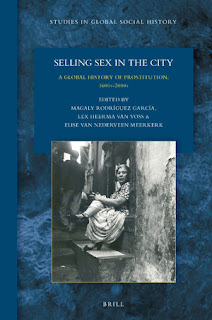Choker necklace and prostitution
The reference source also explains that the choker became popular in the nineteenth century. In its most common early form, it contained one or several rows of pearls. Halfway through the century, a choker made of a velvet band with a pin or pearl became fashionable. The red ribbon version that was tied around the neck became sought-after even before the nineteenth century. During the French Revolution women started wearing them in remembrance of the victims who died at the guillotines. It was the black coloured version of this choker that became associated with prostitutes.
Relation to prostitution
The example always given to illustrate the connection between the ribbon and prostitution is the controversy it caused when Edouard Manet's painting "Olympia" was accepted by the prestigious French Salon in 1865. The lady in the composition was considered a prostitute, not because she was naked, but, among others, because she wore the tied black necklace. Part of the "scandalous" painting is shown above in this blog post.(2) Why the black choker came to be associated with the topic of prostitution is not clear to me. Nor did I find a satisfying answer. If it was an initiative within the trade then surely most prostitutes would have worn them during the second half of the nineteenth century. But was that the case?
Impressions
Paintings by the (post-)impressionists provide interesting information on the appearances of women in that time period. Splendeurs et Miseres, the book that was published together with an exposition in 2016 on the prostitution theme in French art from 1850-1900, shows many examples of painted and photographed prostitutes.(3) Glancing through it, not all of them, however, had a tied black ribbon around their neck. Furthermore, women with other professions did wear it as well, like Berthe Morisot, fellow painter and friend of Manet. And of course, the famous, but with some debate over the painter's objective, the ballet dancers of Degas. Even a German princess had one wrapped around her neck.
Conclusion
So in general, because of the 'scandalous' painting of Manet, I do think there was a connection between wearing a specific choker and prostitution in the nineteenth century. It does not seem to be an initiative within the profession, since not all prostitutes wore this particular choker, while simultaneously women with other professions did. Maybe the tied black choker served symbolically in the minds of the upcoming bourgeoisie as a way to make a physical distinction between prostitutes and other women on the streets. Reality though seems much more bleary than that.
An interesting research topic for a student to dive into...
Notes
(1) I did not find a lot of books on the topic. These could contain information on chokers (though I did not check them): Clare Phillips, Jewelry: from antiquity to the present (London 1996); Amanda Triossi and Daniela Mascetti, The necklace: from antiquity to the present (London 1997). I did find interesting information online, like these: Colin Bisset, "Iconic designs: the choker", ABC National Radio (Australia), 31-08-2019 (listened and read on: 10-09-2021); Megan Garber, "The Long (and Short) History of the Choker" The Atlantic 10-10-2016.
(2) Image taken from Wikimedia Commons, Olympia by Edouard Manet, Public Domain.
(3) Nienke Bakker, et al., Splendeurs et misères: Images de la prostitution 1850-1910 (Paris 2015). Another interesting book on prostitution and French art is: Clayson, H., Painted Love: Prostitution in French Art of the Impressionist Era (2e ed.; New Haven 2003).




Comments
Post a Comment